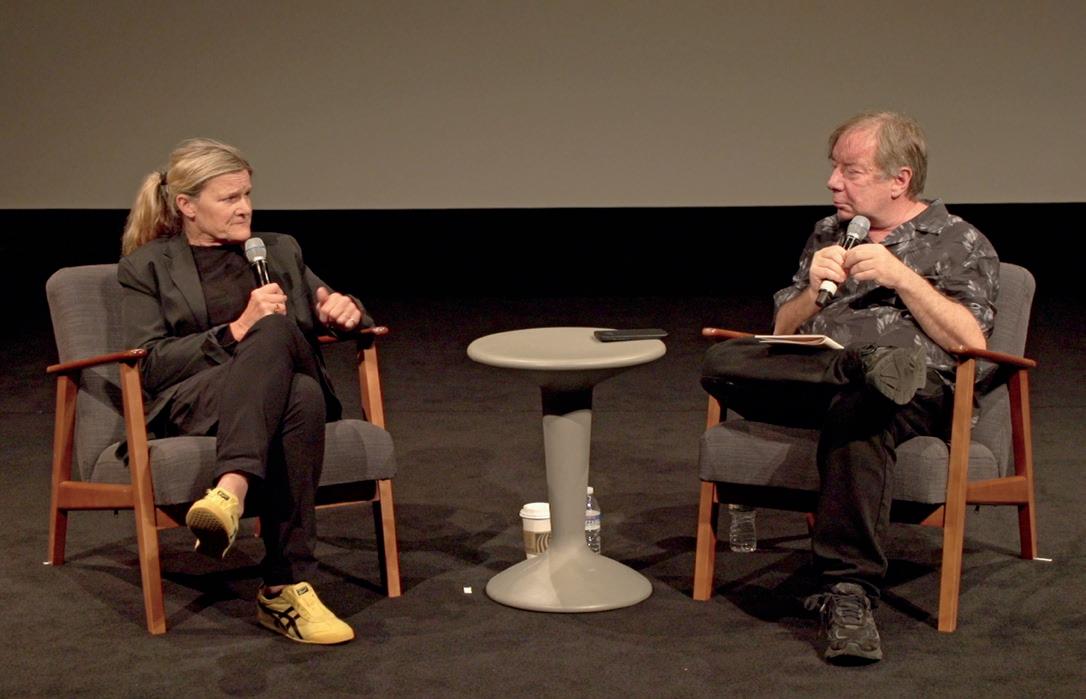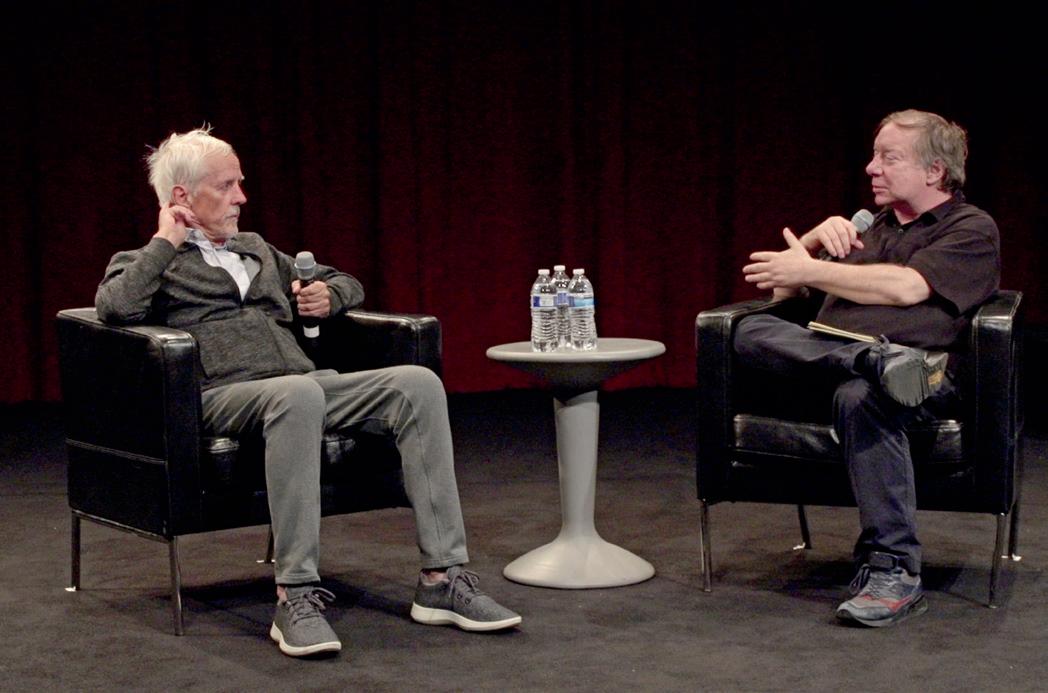The Division of EducationContinuing has been a leader in developing and broadening the sector of continued creative studies in New York City for more than 75 years.
Our dynamic course offerings span a multitude of disciplines, including advertising and design, animation, film, fine arts, illustration and comics, interior design, photography and video, professional development, visual and critical studies, and visual narrative. With a robust online and on-campus curriculum, our program’s global reach connects students from around the world to industry leading faculty in New York City. For more information about the Division of Continuing Education and our course offerings, please visit sva.edu/ce.
Lighting on Assignment: How to Make it Work with Barbara Nitke.
Photo by Catherine Guzman.
Cinematography with Igor Sunara. Photo by Catherine Guzman.
cal, the theoretical, and the creative.
Students are taught the history of the medium, theme, story development, and how to design and animate drawings.
Members of our CE animation community move on to work in the industry as key animation artists in leading production studios in both film and television.
Knowing how limited your time can be, we offer a flexible and alternative schedule that fits a busy lifestyle. Our students have the choice to study with us on campus in
vibrant New York City or choose from a rich selection of online courses. If you are unable to come to New York, then we bring SVA to you.
Our robust curriculum of courses can be found online through our website at sva.edu/ce. If you’re having trouble choosing the course that’s right for you, we have advisors available via phone or email to help guide you through the process. What makes SVACE special? Our courses, our community, and our connections.
CloCkwise
Video Mapping Art with Federico Muelas Romero. Photo by Nivia Hernandez.
Video Mapping Art classroom. Photo by Nivia Hernandez.
Cinematography with Igor Sunara. Photo by Catherine Guzman.
“I love teaching, but CE is rewarding because of the wide variety of students pursuing specific interests—they all come from different backgrounds and levels of knowledge and experience.”
—JOE SINNOTT
previous
and problem solving tools, I’ve tried to help students build confidence and develop repeatable methods for problem solving that they can apply consistently.
How has your practice of teaching photography in CE evolved over the years?
In my experience, CE has always been quick and supportive when it comes to adapting to changes in photography as it relates to broader student interest. They frequently review their course offerings to reflect the feedback they get from students, and you see this reflected in their curriculum. CE is constantly expanding the opportunities for as much experiential learning as possible.
What do you find most rewarding about teaching in CE?
I love teaching, but CE is rewarding because of the wide variety of students pursuing specific interests—they all come from different backgrounds and levels of knowledge and experience. Doing photography seriously is a ton of fun, but it’s also work. Taking a class after a long day of work and life takes a lot of interest and motivation, so whatever happens in any given session of a course, it’s never boring.
For the full story on Joe Sinnott and his work, visit our blog: sva.edu/blog/continuing-education
Behind the scenes photo of Introduction to Studio Lighting from summer
Behind the scenes photo of a student photographer.
CloCkwise
Behind the scenes photo of Introduction to Studio Lighting from summer 2024.
Student photograph by Connie Chweh of model Marisa Spahn.
Behind the scenes shot of students working with a model.
Student photograph by Connie Chweh of model Sarah Lynne.
2024.
opposite Amelia Sutherland, digital photo from Joe Sinnott’s course Introduction to Studio Lighting.
Model: Tristan Halstead.
Jamie Woolfe, Untitled, 35mm film. Brad Steiner, Berlin, 2008, inkjet print, 13 x 19 inches.
Shweta Bist, Subway Prep (Sh!t I Do), 2024, archival pigment print, 20 x 30 inches.
“Personalized feedback from faculty has been the most exciting part of CE courses at SVA because it pushes me to explore new directions in my work. After just a few courses, I’ve begun to dive deeper into the thoughts and feelings behind my photography, resulting in stronger, more powerful, and personal work.”
–Luther Liang
Luther Liang, Untitled, 2024, digital photograph, 4901 x 3921 pixels.
SVA’s Artist Residencies provide a range of programs for photographers and lens-based artists aiming to elevate their practices.
By Rachel Gisela Cohen
opposite
With access to SVA’s renowned faculty, state-of-the-art facilities, and a vibrant artistic community, these residencies offer both on-campus and virtual options to help you develop your work and engage with NYC’s dynamic art scene, whether you’re here in person or participating remotely.
“Photo, Video, and Studio-Related Practices” is an on-campus residency designed for artists working in photography and video who seek to deepen their studio practice through critical feedback and advanced equipment. Hosted by the BFA Photography Department, this program supports a variety of practices, including multimedia, interdisciplinary, and experimental work. Residents have access to cutting-edge photo and video equipment, including full-frame, medium- and large-format cameras, digital labs, analog darkrooms, alternative process labs, fully equipped studios, and industry-standard lighting and recording gear. Distinguished faculty and industry professionals—such as Vince Aletti, Ellen Brooks, Elinor Carucci, Jessica Craig-Martin, Joseph Maida, and Penelope Umbrico—lead individual and group critiques, workshops, and guest lectures. The residency culminates in an exhibition, providing practical experience and professional development.
Artist Residency participant Joanna Perkowska in her studio at SVA. Photo by Jingyao Huang, 2023.
Artwork by Artist Residency participant Naomi Frank. Photo by Jingyao Huang, 2023.




“Fine Arts: Contemporary Practices” is hosted by SVA’s MFA Fine Arts Department and is designed for artists working across diverse media who seek to integrate art with conceptual ideas. This residency offers each participant a private studio in the Chelsea gallery district of New York City, with daily visits from prominent artists, curators, and theorists to stimulate ongoing dialogue. The program includes lectures, gallery walks, museum visits, and workshops, enhancing participants’ professional practices and understanding of contemporary art. The residency fosters a creative environment where artists engage with history and criticism, supported by SVA’s Visible Futures Lab and advanced fabrication tools. This program is ideal for artists interested in various media, including drawing, painting, photography, performance, installation, digital and interactive media, electronics, and sound. For those who prefer a virtual experience, “The Artist Residency Project” offers an online residency tailored to visual artists across disciplines and platforms. This fully online program provides a global residency experience, eliminating geographic constraints. Participants engage with SVA’s distinguished faculty through remote studio visits, individual critiques, and group discussions. The program includes daily activities, professional mentorship, and special lectures from guest artists, critics, and gallery directors. Participants also have access to the full Adobe Creative Suite, ensuring a comprehensive and supportive online residency experience. Each program is designed to support and advance artistic practice, offering unique opportunities for growth and engagement with the art world.
CloCkwise
Artist Residency participant Chaeeun Shin in her studio at SVA. Photo by Catherine Guzman, 2024.
Students in SVA’s BFA Photography and Video facilities. Courtesy of BFA Photography and Video, 2023.
Artist Residency participant Joseph O’Neill in his studio at SVA. Photo by Catherine Guzman, 2024.
from left to right
Ralph Appelbaum interviews guest for Filmmakers Dialogue.
Guests include:
American cinematographer Ellen Kuras.
British television producer and screenwriter Jeff Pope.
Director Rachel Lambert.
Television director and film producer Michael Apted.
Film producer Anthony Bregman.
French novelist and playwright Florian Zeller.
To Continue, Start Here.
The Division of Continuing Education (SVACE) aims to create educational opportunities through which alumni, artists, educators, professionals, and students engage in increasing their knowledge of, and contributions to, the arts.
Our mission is to offer flexible, constantly evolving programs that are multicultural, cross-disciplinary, and global in their approach.
The purpose of continuing education is manifold, but one of its most viable goals is to expose yourself to a new and different world and to build a community there. Every day is an opportunity to learn something— and to reinvent ourselves.
facebook.com/SVACE Instagram: @svacontinued X: @svacontinued youtube.com/CETUBEatSVA vimeo.com/svace sva.edu/ce
front Cover: Joseph Sinnott, CE Dance & Theater Photography Class, 2021, digital still photograph.
baCk Cover: Documentary Portrait Photography: Portrait of NYC with Janette Eckman. Photo by Catherie Guzman.
A student shares a photography zine made for Documentary Portrait Photography: Portrait of NYC with Janette Beckman. Photo by Catherine Guzman.






























